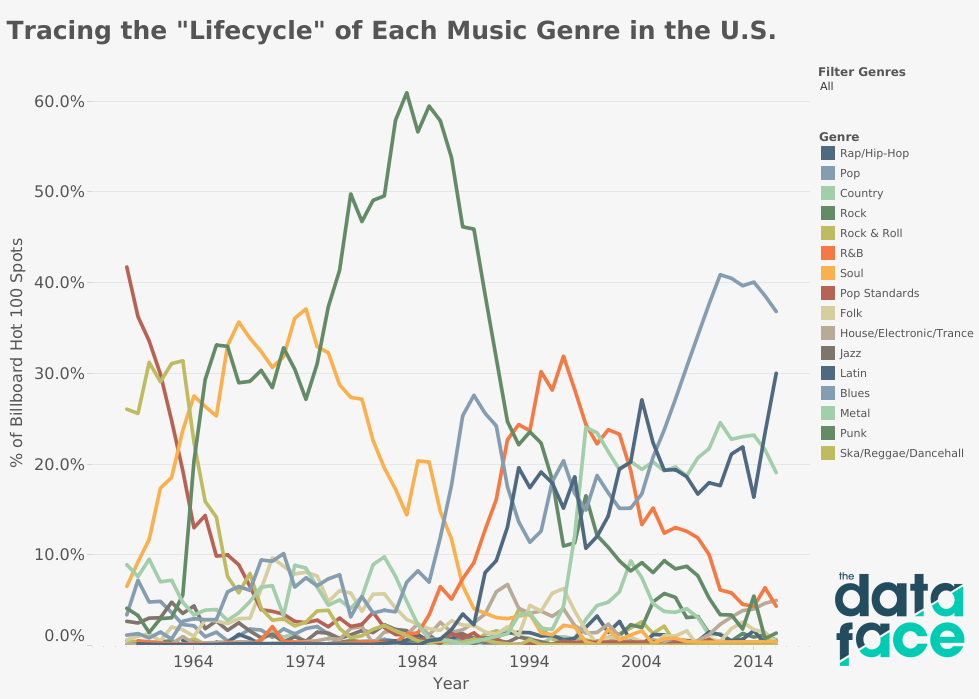Music marks history: it reflects the social and political climate of any era. The study of music shows how the various forces of a time helped shaped its creation. Looking back at a timeline of the most popular music artists from 1969 to the early 2000s displays the history of the U.S. The artist with the most album sales in a year and the genre percentage of songs on the Billboard Hot 100 can map out what music is most popular.
1969
The Beatles dominated popular music, with album sales averaging about 3,000,000. The second most popular was Elvis Presley, with close to 2,000,000 albums. It was the year of Woodstock, a rock music festival with over 400,000 attendees. For many, it showed the counterculture of the 1960s and the “hippie era”.
1969 was the last year in which the United States government gave greater financial support, through the National Endowment for the Arts (NEA) “Music Program”, to opera than it did to other classical music. It was the first year in which it gave any support at all to jazz and folk music.
This year is when music transformed completely. The message and meaning of rock as a force to be reckoned with—a rallying cry—changed. The influence of drugs and psychedelia, along with rock’s heavy-handed approach to pushing the parameters, began to give way to purer intentions and a need to consolidate those gains as a way forward.
It was the year of extremes—the return to a sense of communal responsibility as represented by Woodstock, and the harsh realities wrought by violence and division typified by Altamont Speedway Free Festival and the ongoing trauma of a faraway war.
1970-1971
On April 10, 1970, international media jumped on Paul McCartney’s “self-interview” as an official announcement of a Beatles breakup. Despite the end of the band, their popularity grew. They were yet again at the top of the charts, with almost 4,000,000 album sales.
Jazz was on a decline while disco was on a rise. Jazz marked an extended time in history, one stretching all the way back to the 20’s. It brought African-American culture to the white middle class in the 50s and 60s, but traditional jazz’s popularity died off in the 70s.
The focus of jazz had become the virtuoso soloist and not on a melody people could sing or dance to; at the time, to be popular you had to be at least catchy or danceable. So, jazz evolved into funk. Funk is a danceable combination of psychedelic rock, R&B, soul music, and traditional jazz.
While jazz sounds changed, disco started to rise. Disco had connections to R&B and funk, but it was also born out of the urban gay culture in New York City. Emerging from the U.S.’s urban nightlife scene, disco was a reaction by a counterculture during this period to both the dominance of rock music and the stigmatization of dance music. Come the mid-70s, disco topped the charts for a short while.
1972-1974
The Beatles were finally knocked out of their number one spot in 1972 by Led Zeppelin. Led Zeppelin started as a blues rock band.
Blues rock started when rock musicians performed and recreated Chicago-style blues songs. It was defined by John Mayall and Eric Clapton’s album “Blues Breakers with Eric Clapton” in 1966. Blue rock rose to even higher popularity with Led Zeppelin, The Doors, and Santana.
1975
Glam rock starts to take over the top of the charts. Glam rock is a style of rock music that developed in the UK in the early 1970s. Glam musicians performed in outrageous costumes, makeup, hairstyles, platform shoes, and glitter. One glam rock musician who saw immense popularity later on is David Bowie.
In 1975, Elton John soared through the charts to become the most popular artist, with about 2,500,000 albums sold. His unique blend of pop and rock styles turned him into one of the 20th century’s biggest music icons. While not central to the glam rock genre, he adopted a glam style with oversized glasses and outrageous outfits.
1976
This year, Queen shoots onto the charts and makes it all the way to number five. The British rock band’s fusion of heavy metal, glam rock, and camp theatrics made it one of the most popular groups of the 1970s. Their ability to jump between genres and styles, besides just emphasizing their talent, made them popular even today.
At number one was The Eagles, who just released their album “Hotel California.” The album reflected popular themes at the time, like the loss of innocence, the perils of fame, the exploration of the dark underbelly of the American dream, and the corruption in politics. However, the biggest theme of the time was the fading away of the 60s dream of peace, love, and understanding.
The 1976 presidential election was the first held in the wake of the Watergate scandal, and as the U.S. approached 200 years of existence the above themes started to gain popularity among young audiences who faced disillusionment with the U.S.
1977
The Eagles remained number one, with over 4,500,000 albums sold. Their success is partially because they released “Hotel California” in December of 1976, so most of the album sales were in 1977. The Eagles far surpassed any other artist of the year– second up was Elvis Presley who only sold about 1,400,000 albums.
1980-1984
The Eagles are finally dethroned as number one, replaced by Michael Jackson. He is the first African-American to make it on the charts. People credit his music videos with breaking racial barriers and transforming the medium into an art form and promotional tool. Their popularity helped propel the television channel MTV into a staple of 1980s pop culture. His song “The Girl is Mine” brought both social consciousness and rock guitar to the dance floor, with allusions to an interracial affair.
It’s also during this time that Queen skyrockets back on to the charts, no doubt because of The Game Tour. During this tour, they set the record for the biggest paying audience (250,000 people).
Michael Jackson outsells everyone, though, with almost 4,500,000 albums sold.
1986-1993
Madonna takes the lead. She is not only the first female to reach number one, but she’s the first to have complete control of her music and image. She gathered a lot of attention by refusing to conform to cultural norms, and she redistributed the attention to focus on her music– pushing artistic boundaries and challenging audience perception.
It’s also the first time since 1969 that The Beatles are not in the top ten for bestselling albums. A shift is occurring: rock is about to see a huge drop in popularity while pop is about to see a significant increase. Don’t get me wrong, rock is still hugely popular, but from 1986 to 1992 it drops from holding 57.8% of Billboard Hot 100 spots to just 24.7%.
Pop’s rise in popularity draws on multiple factors. One of which is the fact that it creates a sense of familiarity for listeners, while rock music is still changing and has multiple different-sounding subsections. It also is upbeat, focuses on more light-hearted common themes, and often doesn’t approach taboo topics.
Towards the end of 1986 Whitney Houston enters the scene as the first African-American female on the charts for album sales. Many factors drove her to success: the rising popularity of pop music, her crossover appeal on the popular music charts, and her amazing voice. Houston seemingly had no natural break between the high and low registers of her voice, making it unique with a five-octave range.
1994-1998
R&B music starts to surpass rock’s popularity. Prince, Mariah Carey, Whitney Houston, and Madonna (with her R&B-influenced album “Bedtime Stories”) define the top of the charts. This is the first time in history that the percent of Hot 100 spots R&B occupies is larger than rock or any other genre.
However, this R&B is different from what previous R&B sounded like. It combines rhythm and blues with elements of pop, soul, funk, hip hop, and electronic music. The evolving sound of R&B lends it to be more interesting. It’s different enough from current music to be engaging, but still holds some familiarity with other genres.
The Backstreet Boys’ 1998 album, “All Access”, further proves that the blending of pop and R&B is popular. They reach the top of the album sales chart with 2,700,000 albums.
1999-2005
Eminem runs through the charts to be number one with over 3,700,000 albums sold. His consecutively-released albums “The Slim Shady LP”, “The Marshall Mathers LP”, and “The Eminem Show” add to his album sales number.
His growing popularity is indicative of another shift in music: one towards rap and hip-hop. Alternative hip-hop, introduced way back in the 1980s, resurges in the early 2000s because of rejuvenated interest in indie music. In the 2000s alternative hip-hop retained its place within the mainstream, due in part to the declining commercial viability of gangsta rap as well as the crossover success of artists such as OutKast and Kanye West.
Lil Wayne, Jay-Z, and Usher also hop onto the charts, while Prince, Madonna, and the Backstreet Boys disappear from it.
As time passes, music genres go in and out of style. The process of changing what is popular is always the same, though. What becomes popular surprisingly starts as music that features less genre-typical content– so it’s exciting. However, it needs to be familiar enough to evoke a feeling of comfort. Basically, to start a musical revolution you need to push the audience out of their comfort zone, but not too much.

Hi! My name is Marie, and I am the editor-in-chief of The Mycenaean. I am also President of Model UN and President of Quill and Scroll Honor Society. I love whitewater kayaking and rollercoasters.

Leave a Reply